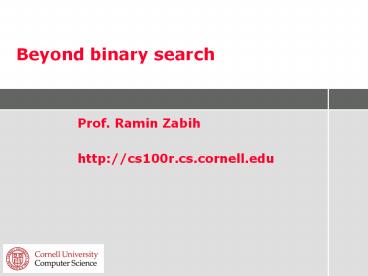Beyond binary search - PowerPoint PPT Presentation
Title:
Beyond binary search
Description:
Beyond binary search Prof. Ramin Zabih http://cs100r.cs.cornell.edu – PowerPoint PPT presentation
Number of Views:117
Avg rating:3.0/5.0
Title: Beyond binary search
1
Beyond binary search
- Prof. Ramin Zabih
- http//cs100r.cs.cornell.edu
2
Administrivia
- Assignment 4 is due tomorrow
- Prelim schedule
- P2 Thursday Nov 1
- Or possibly Tuesday Nov 6
- P3 Thursday Nov 29
3
Beyond binary search
- Can we find the minimum of a 1D convex function
without evaluating derivatives? - Well use a similar interval-shrinking method
- Intervals will be slightly more complex
- Basic idea
- Current interval is a, b
- Assume this is valid (minimum lies inside)
- We know the values of f(a) and f(b)
- Compute f(c) and f(d), where c and d lie inside
the interval a,b - Create a smaller interval
4
Key insight
- We will take advantage of this fact
- Suppose
- A x1 lt x2 lt x3
- B f(x1) gt f(x2) gt f(x3)
- C f is convex
- Then the minimum of f does not lie between x1 and
x2 - Can you prove this?
5
Creating a smaller interval
a
b
c
d
- Initially we know f(a), f(b), f(c), f(d)
- Our 2nd interval will either be a,d or c,b
- But it will contain a point whose value we
already know! - Either c or d
6
What should the spacing be?
- Either our 2nd interval is a,d which has c
inside, or its c,b and has d inside - In either case, we want to include this as part
of the 3rd interval - To avoid doing an extra function evaluation
- If we want to keep the spacing of the points
consistent between iterations, the relative
distances involve the golden ratio - Algorithm is called golden section search
7
Another issue with LS fitting
- LS line fitting has an odd property, which is
always a clue that something is wrong - Its not actually symmetric!
- If you interchange x and y, you get a different
answer - Though its usually close, in practice
- This shows up in the terminology
- Dependent versus independent variables
- The high school notion of least squares doesnt
usually mention this fact
8
More about lying robots
- We assume that the robot tells the truth about
the time, but lies about its position - What if the robot lies equally about both?
- This is actually quite realistic
- Getting clocks synchronized precisely among
different computers turns out to be hard - Lets suppose that there are errors both in the
time and in the position - Sometimes called errors-in-variables
- Usually called total least squares (Golub and
van Loan, 1980)
9
LS residual versus TLS residual
TLS residual
LS residual
10
TLS line fitting
- We seek the line of best fit, where the error is
the sum of the squared residuals - The old residuals had a simple formula
- Vertical distance from the point (x,y) to the
line ymxb is y-(mxb) - Now we need to know what is the distance from
the point (x,y) to the line ymxb - Not the vertical distance! Distance to the
closest point, instead.
11
Distance from point to line
12
Shortest distance is perpendicular
13
What do we know?
- We know the vertical distance
- Its the regular LS residual
14
What else do we know?
- The slope of the line!
15
How does this help?
- We now know 2 sides of a right triangle
- Time to invoke Pythagoras!































